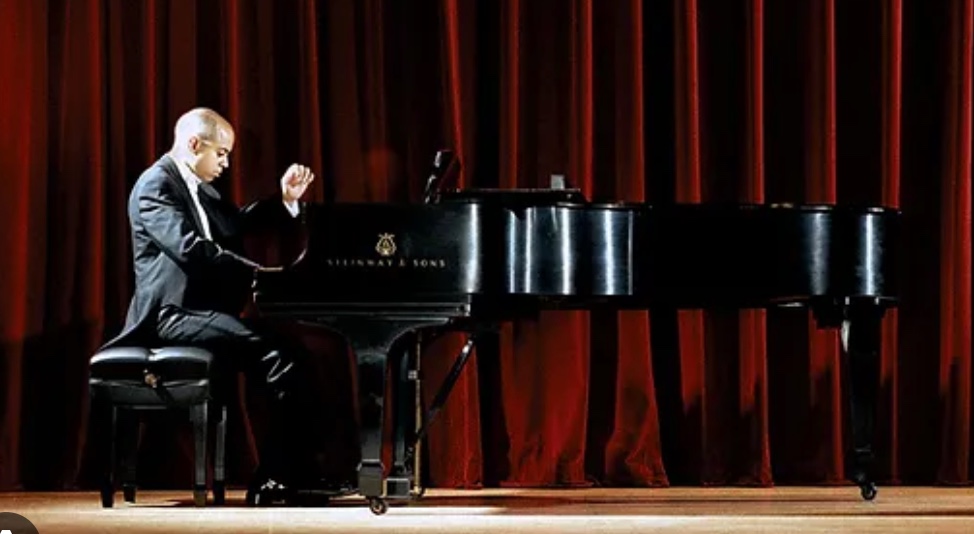by Mike Telin

Goodyear will make his Cleveland debut on Wednesday, November 8 at 7:30 pm in Cleveland Institute of Music’s Mixon Hall. The program will include works by J.S. Bach, Beethoven, Clara Schumann, and Goodyear himself. The concert is part of CIM’s Perspective Series. The event is free but reservations are required.
How did this debut come about? “I just received a call from the Cleveland Institute of Music asking me if I would be interested in doing a mini residency that would be a combination of lessons, a lecture, and a recital.”
He said he was well-aware of CIMs reputation, and the many notable musicians who have graduated from the school. “But of course I’ve never stepped foot inside the building, so everything will be very new.”
Looking forward to giving his lecture, which he said will focus on his path to Beethoven, the pianist said that he first heard the composer’s complete sonatas when he was three years old.
“I heard them in one sitting,” he recalled. “I was so mesmerized by what I was hearing I just couldn’t stop. Each sonata was so different and compelling that by the end I didn’t realize that the day was over. It was like sitting with an assortment of chocolates — I was waiting for the next flavor. And that was the day I decided to become a classical musician.”
Who was the pianist? Vladimir Ashkenazy. “The first LP I heard was his recording of the Chopin four Ballades and I was just taken by the sound of the piano. I wanted to hear more. And that’s when Beethoven entered my life — there was a 13-LP box set staring at me and I thought ‘I have to check this out.’”
Goodyear noted that hearing Beethoven’s sonatas back to back does take you on a journey. And the pathway of that journey changes as you grow older. “Every time I play them it’s a different experience.”
Is there a special period — early, middle, or late — that grabs him more than the others? “That was the problem, I couldn’t just pick one. And that’s how the Sonatathon started. Because I had heard them all in one day, I always thought of them as this large cycle. So when I first started performing them I did it the same way I first heard them — in one day. So the concert would start at 10 in the morning and end at 11 at night. And the audience would go on the journey of hearing them back to back, in chronological order.”
Goodyear has performed seven Sonatathons to date, and he said he still can’t choose a favorite sonata. He did admit that he has personal connections to the “Appassionata” as well as to Opus 111.
In addition to Beethoven’s “Appassionata” Sonata (No. 23), Goodyear’s program will also include J.S. Bach’s Partita No. 5 in G, BWV 829 The Fifth Partita was part of Glenn Gould’s USA debut program. Goodyear played that same program for the 75th anniversary of the Phillips Collection. “Of course Gould’s legacy is all over the place in Toronto. I grew up listening to his recordings, and there’s a studio named after him downtown. It’s also one of my favorite pieces of Bach, so I thought I would showcase that.
There is also a Canadian connection to Clara Schumann’s Three Romances. “I was invited to take part in a recording project with The National Arts Center Orchestra in Ottawa. The orchestra recorded both the Robert Schumann and Brahms symphonies and those were bookended with Clara Schumann so I recorded her Piano Trio, preludes and fugues, Quatre pièces fugitives, and the Three Romances. They are such lovely pieces, and if you’re doing a program that shows different sides of the piano repertoire, they are so breathtaking that they need to be included.
Goodyear will also perform the U.S. premiere of his own composition, Mending Wall (2023), which recently received its world premiere at Wigmore Hall.
“That was a lovely experience. It was my first time there, and it lives up to its reputation. It’s a beautiful hall with an incredible sound. I felt very comfortable performing there.
Mending Wall was commissioned by Wigmore Hall as part of its Lockdown Commission Scheme. “I applied to be one of the composers for the program and they asked me what kind of piece I would be writing. I was taken with the poem by Robert Frost, Mending Wall. During the pandemic so many people had to create walls in order to protect themselves but at the same time there was this communication and I liked the idea of the wall bringing them together.”
Goodyear began composing at eight years old and was a student at Toronto’s St. Michael’s Choir School. Although his first compositions were for choir, he said he wanted to write for orchestra, chamber musicians, and piano. “I was very curious, devouring scores, and studying instrumentation. I loved seeing how composers created their sound worlds — what they would do with harmony. And I was fascinated with the sounds of different instrumental combinations.”
While he never majored in composition, Goodyear said he has had many mentors. “Jennifer Higdon was a powerful influence for me when I was studying at the Curtis Institute of Music. She really encouraged me to find my own voice.”
How did the choral tradition of St. Michael’s Choir School inform his musicianship as a pianist? “I’m very inspired by lyricism both in choral and orchestral music and both of those inform how I approach the piano sound. When it comes to interpretation I do think about the sounds of the voices in the orchestra.”
Click here to watch a performance of Goodyear’s Piano Quartet performed with members of the St. Paul Chamber Orchestra.
Published on ClevelandClassical.com November 5, 2023.
Click here for a printable copy of this article



